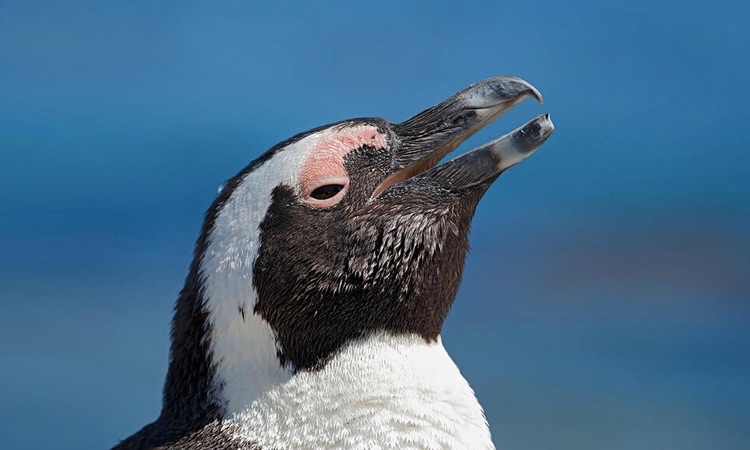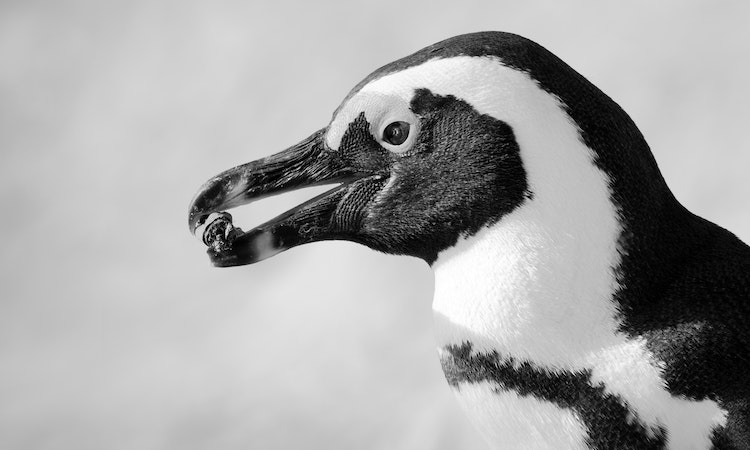When you’re watching penguins feast on krill or fish, it’s natural to question whether they possess teeth. The simple answer is, no they they do not have teeth.
Instead of the typical chompers that mammals have, there are serrated needle-like spines inside a penguin’s mouth which make gnawing their dinner easier. Effectively swallowing prey becomes simpler with this unique adaptation!
The spines can sometimes appear like teeth, but they are actually there to secure the prey and keep it from escaping.
The barbs point inward so that the unlucky creature has no means of escape when entering the penguin’s mouth. Once caught in their grip, its fate is sealed.
At first glance, those spines protruding from a penguin’s open mouth may look like teeth, but they are merely soft appendages that assist the bird in consuming its fishy meals.

Do Penguins Have Teeth?
As you may have established by now, penguin teeth do not exist. Observe a photograph of a penguin with its beak wide open and you’ll spot multiple uneven protrusions. It’s tempting to believe those are rows of teeth, but the truth is much more fascinating.
What Are the Barbs Inside a Penguin’s Mouth?
Penguins possess remarkable serrated spines that are arranged in rows in their mouths, which bend inward towards the bird’s throat.
This design allows prey to effortlessly travel down to their stomachs. A penguin will even eat its fish head first, so as not get stuck on the way down!
Penguins rely on their serrated, barbed spines to snatch onto any slippery prey that attempts to escape. It is similar in concept as a fish hook with a barb fastened at the end.
This helps secure the catch after all of its hard work! Without these barbs, it would be incredibly difficult for penguins to retain whatever they managed to snag.
What Do Penguins Eat?
Penguins are voracious eaters, consuming many different types of ocean creatures, from krill that look like shrimp to squid and fish. Depending on the species, a penguin’s diet could include herring for king penguins or mullet fish for Galapagos penguins. Even smaller octopi have been known to be an occasional meal!
The size of a penguin is predominantly dictated by the magnitude of their prey. The largest class, emperor penguins, consume lantern fish that can grow over a foot long! On the contrary, Humboldt Penguins feed on much smaller sardines – scarcely reaching only a few inches in size.
It’s logical to realize that because of their size, large penguins must consume larger prey in order to meet the nutritional requirements for their bodies.
The eating habits of penguins are determined by their geographic location. Those residing in the frigid Antarctic region mostly feed on krill, as it is more readily available. Meanwhile, those inhabiting warm-water climates primarily subsist on an ample amount of fish.

Do Penguins Chew Their Food?
Penguins don’t chew their food due to the spines in their mouths, instead they swallow it whole. The fascinating part is that they can digest a large fish or squid without chewing!
Pebbles are actually responsible for this incredible process of digestion as penguins consume them with every meal and store them in an organ located near the stomach called a gizzard which pulverizes everything within.
Why Do Penguins Eat Pebbles?
You may think it’s absurd, but it is in fact reality: Penguins don’t masticate their meals. They consume pebbles instead. This quirky peculiarity of penguins surely comes as a surprise to most people!
Penguins have a unique way of processing their food. They gulp pebbles ranging from small to large before consuming any fish or other prey. This helps them break down the particulate matter in their stomachs, aiding digestion and providing essential nutrition for these delightful birds!
This gastric-processing technique is not exclusive to penguins; a variety of avian species, like ostriches, crows and chickens also consume pebbles to facilitate digestion.
If you own a parakeet, you must provide your pet with something called grit in its cage. Just as penguins need pebbles to aid in digestion, so do parakeets rely on this gritty substance to help them break down the seeds they dine upon daily.
Other Questions About Penguins
What Becomes of the Pebbles a Penguin Swallows?
As they go about breaking down the food in a penguin’s digestive system, the pebbles swirl around and take on a glossy finish. Over time, even smaller pebbles will eventually disintegrate with this continuous motion.
However, some larger pebbles could possibly pass through a penguin’s digestive system and be excreted in its droppings. Additionally, researchers have discovered pebbles inside the stomachs of deceased penguins during autopsies.
Why Do Penguins Shake Their Head After Eating?
Have you ever caught an episode of a wildlife show featuring penguins? If so, I’m sure you noticed them pointing their beaks skyward and shaking their heads. Surely this intriguing behavior begs the question – what is the explanation behind it? Well, that’s one of the most fascinating aspects about these Antarctic avians!
Penguins possess an exceptional organ, located above their eyes, known as the supraorbital gland. This unique feature helps them absorb salt from their food and water intake without becoming overly hydrated.
When a penguin shakes its head or makes a sneezing sound, it’s actually expelling excess salt in order to maintain equilibrium! With this extraordinary adaptation, penguins can enjoy salty meals without fear of dehydration.

Is a Penguin’s Beak Sharp?
Indeed, penguins possess a sharp and curved beak that allows them to grab their prey. Such as krill, squid, and fish with ease. This unique feature grants this bird an advantage over other sea creatures when hunting for food.
Penguins are astonishingly adept at diving and catching prey. Submersing themselves up to 1,600 feet in the ocean, they have easy access to a plentiful supply of food.
While plummeting through large schools of fish, these remarkable creatures can snatch their meal with ease before returning it back up to the surface – all held delicately in its beak until ready for consumption!
Do Baby Penguins Have Teeth?
Are young penguins equipped with teeth? Surprisingly, no. Even though their adult counterparts are toothless, the same is true for baby penguins. However, instead of traditional teeth they have something called an egg tooth, a unique trait amongst avian species!
With its pointed formation and location atop the beak, an egg tooth bears a striking resemblance to a human’s pearly whites, but never fear! It is merely a small horn-like protrusion exclusive to young penguins.
With a specialized “tooth,” penguin hatchlings are able to penetrate the sturdiness of their eggshell and make their grand entry into the world. This unique apparatus is invaluable in aiding them through this crucial process, eventually shedding off after its purpose has been fulfilled.

How Do Young Penguins Take in Nourishment?
Newborn penguins, or nestlings as they are often referred to, rely heavily on their mothers for the first few months of life. As part of this process, a mother must feed her little ones by regurgitating the prey she has eaten mixed with pebbles into the mouths and throats of these fuzzy newborns.
While the thought of regurgitating food may sound revolting to us humans, it is actually a very natural process for penguin parents. Some species are able to consume prey and store until they can bring it back up as digestible nourishment for their nestlings. This method ensures that baby penguins get just what they need in order to grow healthy and strong!
As the young penguins mature, they learn how to capture their own food and swallow pebbles for digestion. With caring instruction from their mother, these fledglings remain with her until reaching 5-6 months of age, at which point they are equipped to thrive on their own.
Can the Barbs in a Penguin’s Mouth Cause Injury to People?
Have you ever contemplated whether the penguins at your local zoo nip their zookeepers when being fed? And if that is indeed true, do the stiff hairs inside their beaks cause harm to those feedings them?
Despite popular belief, zookeepers don’t usually get bitten by penguins. It generally happens when they are feeding the birds and the animals become overly enthused.
The spines in a penguin’s mouth may scratch or even draw blood from their handlers’ skin but contact with its beak is an entirely different matter altogether!
Penguins possess a menacingly sharp beak with a curved end that can cause harm if one were to come in contact with the bird. For this reason, zookeepers are always equipped with gloves before feeding penguins; not only for their own safety but also because they’re dealing with dead fish as well.
Penguins rely on the strength of their beaks when facing off against predators such as sea gulls, mongooses and caracals. An African penguin in particular uses its sharp bill to effectively ward off any potential threats.
During mating season, male penguins engage in aggressive battles with their beaks to compete for a mate. They push and peck at one another to determine who is the strongest and healthiest. Although these contests can cause injury, they are ultimately beneficial as they help ensure that only the fittest of males will end up successful in securing a female partner.


